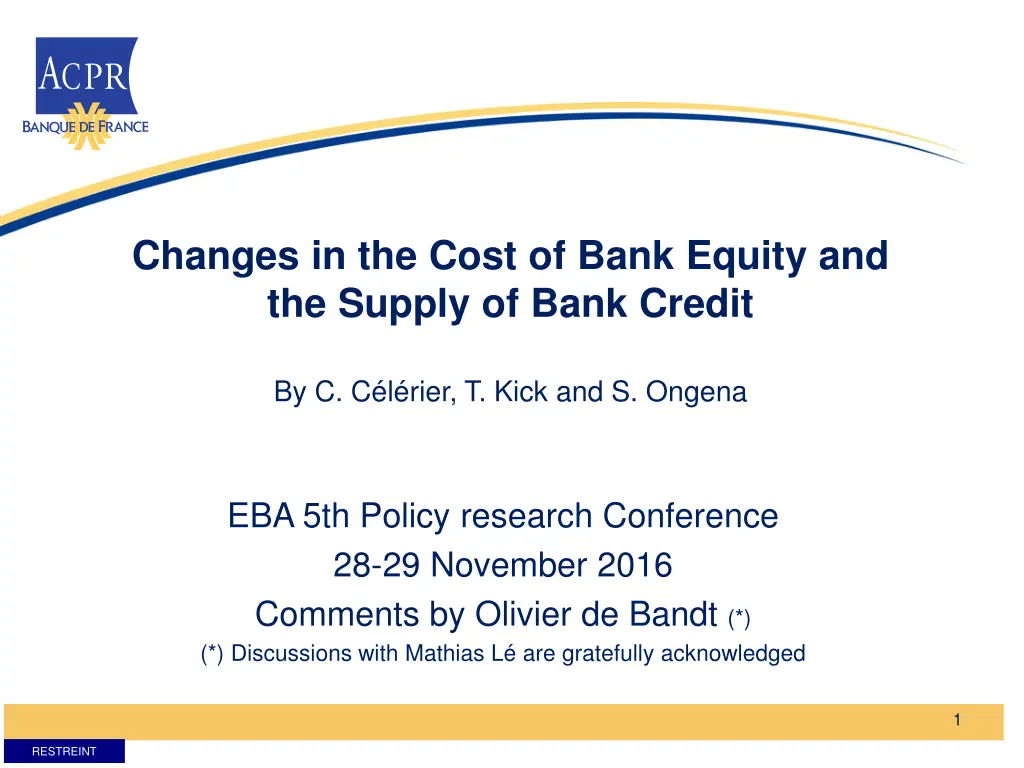
Changes in Bank Equity Cost Impact on Credit Supply
Discover how changes in the cost of bank equity affect the supply of bank credit and financial stability. Explore findings on bank capital, lending mechanisms, and the impacts of specific reforms in Italy and Belgium. Gain insights into the crucial challenges faced in understanding the relationship between bank capital and lending practices.
Download Presentation

Please find below an Image/Link to download the presentation.
The content on the website is provided AS IS for your information and personal use only. It may not be sold, licensed, or shared on other websites without obtaining consent from the author. If you encounter any issues during the download, it is possible that the publisher has removed the file from their server.
You are allowed to download the files provided on this website for personal or commercial use, subject to the condition that they are used lawfully. All files are the property of their respective owners.
The content on the website is provided AS IS for your information and personal use only. It may not be sold, licensed, or shared on other websites without obtaining consent from the author.
E N D
Presentation Transcript
Changes in the Cost of Bank Equity and the Supply of Bank Credit By C. C l rier, T. Kick and S. Ongena EBA 5th Policy research Conference 28-29 November 2016 Comments by Olivier de Bandt (*) (*) Discussions with Mathias L are gratefully acknowledged 1 RESTREINT
Summary and main findings 1. Crucial challenges for financial stability: improving our knowledge regarding the relation between bank s capital and bank s lending. What are the recent contributions in this field? Capital requirements and lending : Aiyar et al. (2014), Fraisse et al. (2015), Jimenez et al. (2016), Behn et al. (2016) Leverage ratio and lending? No much work on this subject until now This paper is one of the first to examine the specific role of the cost of equity It uses natural experiments (ACE) in two distinct countries (BE&IT) to assess to which extent a decrease in the (relative) cost of capital affects (i) bank capital and then (ii) bank lending 2. Mechanisms and identification strategy Reducing the cost of equity has three potential effects (according to the paper) : income effects : cost saving are additional resources to lend cost of funds : lower funding cost then translate into loan rates capital structure : relaxation of capital constraint by increasing equity Important ingredient of the empirical setting of the paper : use legislative change regarding capital in IT or BE to assess change in lending in DE this prevent endogenous changes in legislation ! 3. Main Findings of the paper Reforms induce an increase in bank capital in both countries (the reverse is also true) Treated banks expand lending (abroad) relatively more when the cost of equity decreases (the reverse is also true!) The impact of the reforms is large : Italian and Belgian banks increase their lending by more than 40% relative to other banks 21/08/2025 2 RESTREINT
Discussion (1/3) clarification questions 1. The reforms: It is not totally clear to me what the reforms are doing (tax incidence issue= who benefits from the tax cut ? Issuer or investor?): IT : lower corporate taxes for notional income on equity-finance investment BE : notional interest on equity deducted from taxable income It would be valuable to have a fictitious case studies (in the spirit of footnote 7) to understand in details the mechanisms at work 2. The results and the mechanisms: The findings indicate that ACE leads to both : Relatively higher capital ratio (5% to 20%) Relatively higher lending volume abroad (50% to 70%) A bit puzzling because most of the literature (cited above) find that higher capital ratios are generally associated with lower lending The paper could gain by discussing more these results and linking them to the three distinct channels mentioned in the introduction Say differently, at this stage the paper uncovers interesting effects but it is a bit short on how they work precisely The magnitude of the effects are quite sizeable: For instance, in the firm level specification you find a 60% relative increase in lending by firms borrowing from at least one Italian firm Maybe banks cut and expand much more dramatically abroad than at home, but these figure are striking 21/08/2025 3 RESTREINT
Discussion (2/3) suggestions We don t expect all the banks to react in the same way: banks which are initially more constrained by regulation should react more to the reforms this suggests to interact the treatment dummy with pre-reform capital ratio Regarding the mechanisms discussed, there could be an indirect cost of fund channel: In your view, the direct channel is related to the lower total cost of equity But as Admati et al. (2013) underline, when banks increase their capital ratio, it makes the whole debt less risky and thus cheaper You could test this effect by looking at the effect of ACE on the interest expenses of banks. 21/08/2025 4 RESTREINT
Discussion (3/3) suggestions 1. Identification Strategy (1): It seems to me that the setting is well suited for an instrumentation : You look at : ??,?= ? + ? ????,?+ ??,?(first-stage) ??,?,?= ? + ? ????,?+ ??,?(reduced form) Why not instrumenting the change in capital ??,?by the reforms : ??,?,?= ? + ? ??,?+ ??,?(second-stage) Allows comparison of elasticity with other recent papers 2. Identification Strategy (2): Regarding your loan level estimation, I would be tempted to add parent country dummies : It is in the spirit of your robustness limiting the sample to foreign banks only It would prevent capturing shocks hitting some foreign countries where control banks are incorporated : This is a problem if firms have some patterns that makes them borrowing more systematically from a specific pair of foreign banks, i.e. if firms borrowing from Italian banks borrow more often from Portuguese banks rather than Polish banks 21/08/2025 5 RESTREINT






















